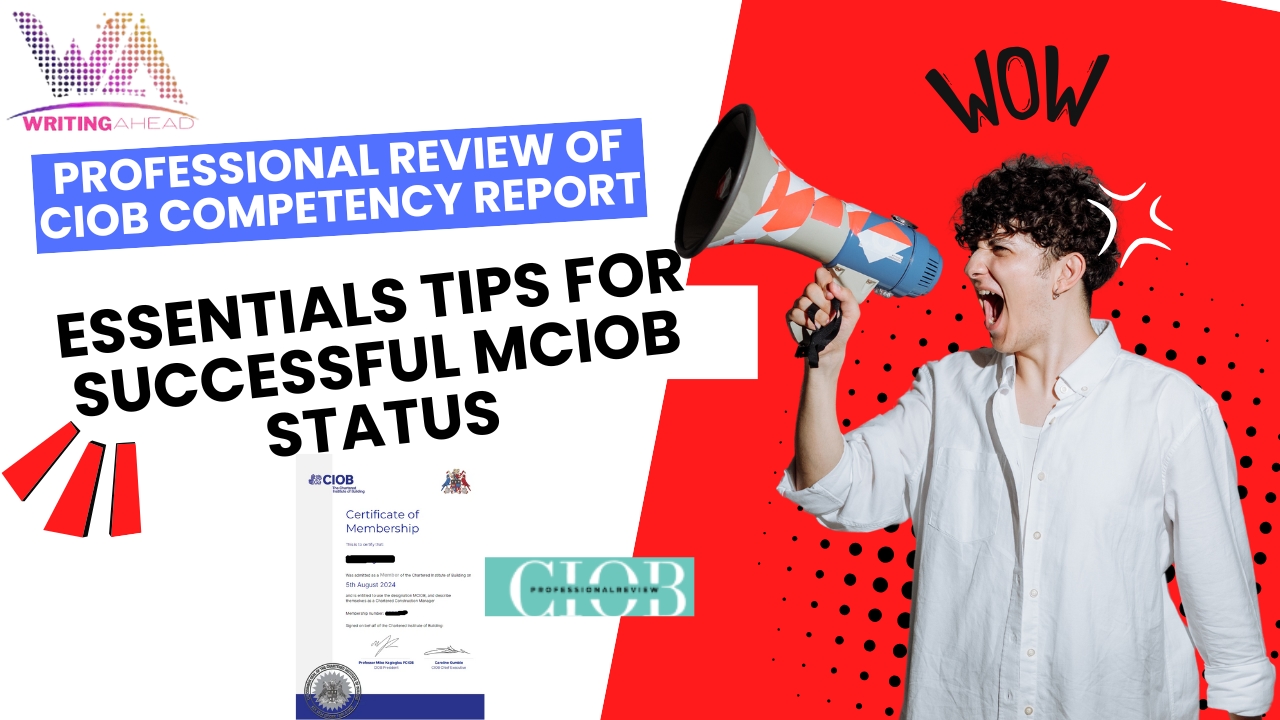A Step-by-Step Guide Featuring CIOB Professional Review and CIOB Membership – in Simple Language
If you’re planning to become a Chartered Member of the Chartered Institute of Building (CIOB), one of the most important steps is writing your CIOB Professional Review Report. This report is your chance to show what you’ve done in your construction career — and how your skills and experience meet the standards of CIOB Membership.
The good news? You don’t need to be a writer or have a university degree to complete it. You just need to explain your real work clearly and honestly.
This easy-to-follow guide will walk you through exactly how to write your CIOB Professional Review Report, including what to include, how to structure it, and how to make it stand out.

What Is the CIOB Professional Review Report?
The CIOB Professional Review is the final step before you become a Chartered Member (MCIOB). Instead of an exam or test, the CIOB asks you to write a report that shows:
Your experience in construction
Your technical knowledge
Your management and leadership skills
Your understanding of ethics, safety, and professionalism
Your commitment to continued learning
The CIOB Professional Review report is usually around 2,000 to 3,000 words and focuses on your real-life experience — not theory or classroom knowledge.
Before You Start Writing: Make Sure You're Eligible
To apply, you should:
Be a current CIOB Member (Associate or Applicant level)
Have at least 3 to 5 years of experience in construction
Be working in a supervisory, technical, or managerial role
Have completed Continuing Professional Development (CPD)
Be ready to write honestly about your work
If you don’t have a formal qualification, you can still apply through the Experienced Practitioner Assessed (EPA) route. The CIOB focuses on your experience and what you’ve actually done in your job.
What the Report Must Include
In your report, you’ll be asked to show how your experience meets 11 core competencies set by the CIOB. These are:
Construction Management
Construction Technology
Health, Safety and the Environment
Quality Management
Commercial, Contract and Financial Management
Planning and Programming
Project Management
Professionalism and Ethics
Continuing Professional Development (CPD)
Sustainability
Equality, Diversity and Inclusion (EDI)
You must write about each competency separately, using examples from your own work.
How to Structure Each Section of Your Report
A great way to write about each competency is to follow the STAR method:
S – Situation: What was the project or task?
T – Task: What were you responsible for?
A – Action: What exactly did you do?
R – Result: What was the outcome?
Let’s break this down with an example for Health, Safety, and the Environment:
On a residential tower project, I was responsible for ensuring site safety. I noticed an increase in minor injuries, so I introduced weekly toolbox talks and daily safety checks. As a result, the incident rate dropped by 45% in three months.
Keep it short, clear, and focused on your personal actions — not just what the team did.
Tips for Writing a Strong CIOB Professional Review Report
Here are some helpful tips to make your report stronger:
Use “I”, Not “We”
CIOB wants to know what you did. Avoid writing, “We completed the project...” and instead write, “I managed the subcontractors...”
Be Honest and Clear
You don’t need to use complicated words. Simple, professional language is best. Just explain what you did, how you did it, and what the result was.
Include Numbers and Outcomes
Where possible, include figures. For example:
I managed a $2.5 million budget and reduced waste by 20%.
Don't Skip Any Competencies
Make sure you write something for all 11 areas. Even if you don’t have a big example, explain how you handle that part of your job.
Keep It to the Point
Stick to one or two strong examples per competency. Don’t go off-topic or write too much detail.
What Else You Need to Submit With Your Report
Along with your CIOB Professional Review Report, you’ll also need:
A professional CV (resume) — clearly showing your job roles, dates, responsibilities, and achievements
A CPD Record — listing training, workshops, or self-learning from the last 12 months (aim for at least 30 hours)
Proof of identity (like a passport or licence)
Any qualifications or certificates you have
All documents should be uploaded through the CIOB online portal.
How Long Does the Assessment Take?
Once you submit everything, the CIOB assessors will:
Review your report
Contact you if they need more information or a short interview
Notify you of the result, usually within 8 to 12 weeks
If approved, you’ll become an official MCIOB — a Chartered Member of the CIOB.
Why CIOB Membership and the Professional Review Matter in 2025
As of 2025, there’s a growing demand for Chartered construction professionals in both public and private projects — especially in countries like Australia, the UK, and UAE. Clients and employers are looking for people who can prove they work safely, ethically, and professionally.
That’s why more companies are encouraging their staff to complete the CIOB Professional Review and gain full CIOB Membership.
With sustainability, digital construction, and building safety now top priorities across the industry, having MCIOB status shows that you meet the highest standards.
Final Thoughts: You Can Do This
Writing your CIOB Professional Review Report might seem like a big task, but if you break it into steps and focus on your own real work, it becomes much easier.
Remember:
You already have the experience — just write it down clearly
Follow the STAR method
Cover all 11 competencies
Use simple, honest language
Get someone to proofread your report before you submit
📩 Need help? We support construction professionals with templates, examples, editing, and one-on-one review services to help you complete your CIOB Professional Review confidently.
You’ve done the work — now it’s time to get the recognition. Start your journey to Chartered status today.
